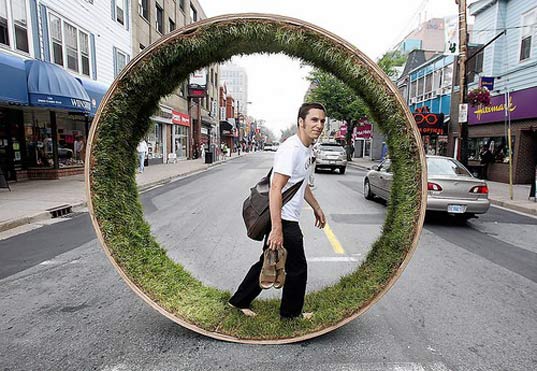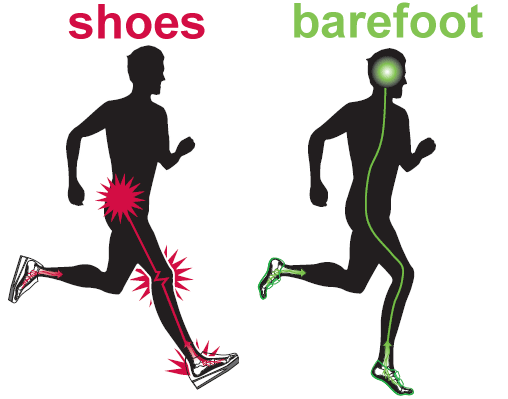- Strengthen the muscles in your feet
- Be injury free thanks to proper foot and body mechanics
- Increased sensory perception (and running pleasure)
- Run easier and faster and be injury-free for life
Check it out…
Look at the illustration below. When a runner strikes the ground wearing running shoes, the positive heel (all that foam/air/gel cushioning) causes him/her to heel strike, then ‘roll’ and push off. This is NOT how our body is designed to run. Look at the runner on the right. When you’re barefoot (or nearly barefoot) you will land gently and feel the ground below your feet. This is very important to be a healthy and injury-free runner. Now you try! Run 20 yards in your runners, then do the same barefoot. Have someone watch you just in case you fall over from glee!
A Few Common Questions
Q: What’s wrong with running shoes?
A: A lot. Running shoes “shield” your feet and body from the natural cushioning it’s designed for, actually causing more impact to your body, not less. Nearly all traditional running shoes have a thick midsole at the heel which causes heel strike, another major injury cause. Read more here…
Q: So, what are you saying?
A: Toss your shoes away and run barefoot! But wait, there’s more! There are things to consider first, that’s where this site comes in. Read on…
Q: I heard about barefoot running, doesn’t it hurt?
A: If you jump right into it, then in short, yes. You’ll use muscles you’ve never used before. As you transition to barefoot running, you should start slowly. Ease into your mileage and listen to your feet. Most runners require 3-4 weeks before achieving ~80% of their regular mileage sans shoes.
Q: OK, I’m on board with this barefoot running, but can’t always run sans shoe, then what?
A: As many other runners, I had the same problem. There are many environmental and sometimes social reasons for wearing “running shoes”. For this and other reasons there ‘alternatives’ are slowly becoming available.
A few medical quotes
“Running related Chronic injuries to bone and connective tissue in the legs are rare in developing countries, where most people are habitually barefooted.”
Michael Warbutton – Gateway Physiotherapist Australia. 2001
Barefoot training helps correct form and reduces foot, shin and muscle injuries.”
Dr. William A. Rossi, D.P.M. 1999.
“Where barefoot and shod populations exist, as in Haiti, injury rates of the lower extremity are substantially higher in the shoe wearing population.”
Robins SE and Hanna AM – Running related injury
“…natural gait is impossible for the shoe-wearing foot …and it is equally impossible for any orthotic to achieve “correct” foot and body balance …no matter how correct and precise the biomechanical design.”
Dr. William A. Rossi, D.P.M. “Why Shoes Make ‘Normal’ Gait Impossible.” Podiatry Management
Getting Started
When you think of someone running barefoot, you might think “I could never do that, my feet are too _____”. (fill in your excuse reason)
The fact of the matter is YOU too can run, hike, dance, walk (even money if the mood were to strike) barefoot! Now, I’m not a trainer nor an MD, listen to your body and go slow, that’s the key. But if you’re ready to get started then read on.
Here are 5 tips to get you ‘barefooting’ safely in no-time:
1) Go barefoot whenever you can. At home, in the garden, in the office (if you can), playing with the kids, taking the pooch for his daily walk. The more your feet rediscover what they’re capable of, the better your feet will feet and so will your soul. Take a look at our minimal shoe reviews to find a pair best suited for your lifestyle.
2) Stop and think. Even I catch myself about to put on my flip-flops (I live in Florida) before heading out the door with our lab. Stop and think, “do I really need those stinkin’ shoes to go?”. Sure, certain social or public situations require them, as do certain environmental conditions. Just take 5 seconds and consider if you can manage without shoes, if you can, go for it!
3) Start slow, but start. If you’re a runner you have a great opportunity to run lighter, faster, injury-free and even discover a new running outlook. But don’t ditch those sneaks and go unshod without a plan. Well, you can but your calves will hurt, the feet will tingle, and you may be sore where you’ve never been sore before. When running in shoes (Barefoot 101) the muscles in your feet have been asleep for a very long time. Be patient as they strengthen over time. For the average runner, that means 5-10 minutes of barefoot running on pavement per run for the first little while.
4) Let go of the stigma. Isn’t it ironic how ‘going barefoot’ has negative social stereotypes; while gymnasts, dancers, martial artists and other pros depend on their naked feet. Why the taboo of being naked from the ankle down? So the next time you feel uncertain of going barefoot, just remember that you’re doing the right thing for your body. And if someone asks, just say your feet need a workout.
5) Listen to your feet. No different than those aches your body may feel after a killer gym session, long training run, hardcore trail ride, or showing off your skills on the ski hill. As you introduce barefoot running or walking into your training, you’ll notice that shorter than usual runs will cause muscle and arch tenderness. Don’t plan on that Sunday morning 15 miler training dash for at least 3-4 weeks. Don’t force it. You’re awakening, straining and training muscles that have been asleep for a long time. At the same time, those ‘comfy’ shoes have thinned your soles and strengthening of them will take time, again, patience.

